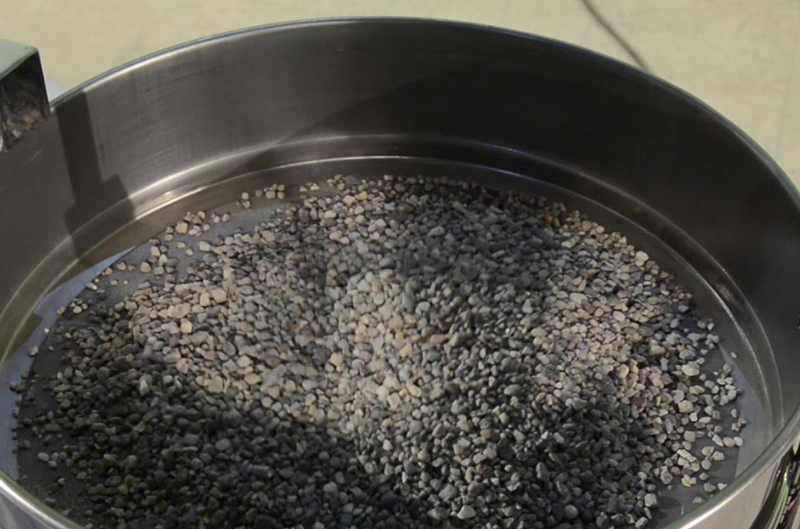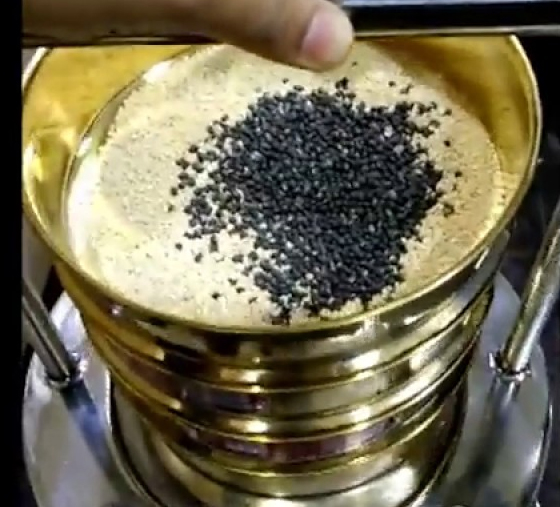Sieve Analysis Test for Fine Aggregate is mainly used to sieving aggregates, and generally a sieve between 100 mesh and 400 mesh is selected. Currently, a construction company is carrying out a road construction project and needs to test the particle size distribution of the fine aggregate used in the asphalt mixture.

Some common challenges that may arise during sieve analysis testing include:
1. Sample preparation issues: If samples are not properly prepared, such as being too wet or containing too much debris or contamination, the accuracy and reproducibility of test results may be affected.
2. Insufficient shaking or agitation: If the sieves are not shaken or agitated for sufficient time or force, some particles may fail to pass through the sieve or may remain on the wrong sieve, which affects the accuracy of the analysis. result.
3. Sieve clogging: If the material being tested contains fine particles that will block the opening of the sieve, this will affect the accuracy of the results and make it more difficult to separate the particles into fractions of different sizes.
4. Inaccurate weighing: If the weighing equipment is not properly calibrated or maintained, it will affect the accuracy of the results and lead to errors in the particle size distribution calculation.
5. Operator error: If the operator is not properly trained or does not follow proper procedures for performing sieve assay testing, the accuracy and reproducibility of results may be compromised.
6. Batch-to-batch variability: If the material being tested varies significantly between batches, it may affect the accuracy and reproducibility of results, and additional testing may be required to ensure consistency.

They collected representative samples of fine aggregate and performed sieve analysis tests in the laboratory. The results of the sieve analysis test show that the particle size distribution of the fine aggregate meets the specifications required by the project, and the passing mass percentage of each sieve hole is within the allowable range, and the particle size distribution curve shows that most of the particles are within the required particle size range. Based on the results of the sieve analysis test, the construction company can confirm that the fine aggregate is suitable for use in asphalt mixes and meets the particle size distribution requirements. This helps ensure the quality and performance of the pavement and prevents any problems that may arise from the use of unsuitable fine aggregates.
In addition, construction companies use the results of sieve analysis tests to optimize the amount of fine aggregate in asphalt mixes, which helps reduce material waste and costs while maintaining the desired particle size distribution.
The procedure for conducting sieve analysis testing of fine aggregates is similar to that of other materials and includes:
1. Collect a representative sample of fine aggregate.
2. Dry the sample to remove moisture that may affect the results.
3. Weigh the sample and record the weight.
4. Set up a stack of sieves with the smallest holes at the bottom and the largest at the top.
5. Place the sample on the top sieve and close the lid.
6. Use the sieve shaker to stack the sieves for the specified time, usually about 5-10 minutes.
7. Weigh the material retained on each sieve and record the weight.
8. Calculate the percentage of material retained on each sieve by dividing the retained weight by the total weight of the sample and multiplying by 100.
9. Plot the particle size distribution curve on a graph by plotting the percentage of material retained on each sieve versus the size of the sieve opening.
Sieve analysis test for fine aggregate is a common laboratory test used to determine the particle size distribution of fine aggregate used in concrete, mortar or asphalt mix. Fine aggregate is typically defined as material less than 4.75 mm in size, and the sieve ana analysis test is conducted using a set of sieves with openings ranging from 4.75 mm to 75 microns.
For the screening of fine aggregate, the recommended mesh size should be determined according to the characteristics of the specific particle material, the purpose of the test and the required screening accuracy. The following mesh range can be considered as a reference:
Fine sand: It is generally recommended to use a sieve with a mesh size of 200 or more for screening to ensure the fineness and uniformity of the sand.
Stone powder: A sieve with a mesh size of 150 or more can be used for screening.
Fly ash: It is recommended to use a sieve with a mesh size of 200 or more for screening to ensure fineness and uniformity.
| Fineness modulus | Applicable range |
| 3.7-3.1 | Coarse sand, commonly used in large-volume concrete, hydraulic concrete, etc. |
| 3.0-2.3 | Medium sand, widely used, suitable for general construction projects. |
| 2.2-1.6 | Fine sand, commonly used in high-strength concrete, plastering mortar, etc. |
| 1.5-0.7 | Extra fine sand, mainly used for decorative mortar, wear-resistant flooring, etc. |
Address:China,Yanjin county forest park gate to the west 1000 meters north road.